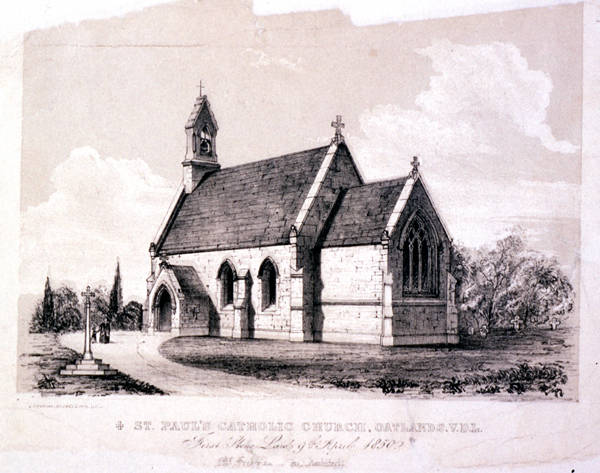 |
 |
|
Catholicism
Catholics have usually comprised about a fifth of Tasmania's population. Their proportion fell to 17 percent in 1929–47. Unprecedented migration from continental Europe lifted it to 24.6 percent in 1981, but by 2001 it had retreated to 19.2 percent, the lowest level in any state or territory. Nevertheless, for over a century, Catholic worshippers have constituted the largest group of Tasmania's regular churchgoers. Tasmania's first Catholics were convicts, and most of their co-religionists who arrived free before the 1880s were economic refugees from Ireland. Their denomination benefited little from the Church Act (1837), which gave Tasmania its wondrous legacy of Georgian and early Victorian churches, rectories and parish halls. The legislation offered building subsidies on a £-for-£ basis, but in the first fifteen years of its operation the Catholics' poverty meant they could raise enough to qualify for only a fifth of what they would have received had grants been made on a per capita basis. The arrival in 1844 of the first Bishop of Hobarton, Robert Willson, brought effective leadership. Yet it was not until the 1860s, when a minority of Catholics began to prosper through farming, small-business and in the professions, that their church began to make a substantial contribution to the colony's built environment. Construction of the first St Mary's Cathedral (1866) was facilitated by the gift of £10,000 from a convert, pastoralist Roderic O'Connor. Catholics have undertaken important welfare work, including marriage guidance, much of it now co-ordinated by Centacare. From 1847, Sisters of Charity aided transportees and the destitute. In the 1870s, they took charge of St Luke's Ragged School, South Hobart, and opened an orphanage. At Mount St Canice (1893), the Good Shepherd Sisters ran for women what grew into the largest private charitable institution in the state. Hospitals, the Boys' Town orphanage at Glenorchy, homes for the aged and hospices for the dying followed. Lay organisations, notably the St Vincent de Paul Society, aided great numbers of the less fortunate. The Catholic Women's League established hostels for country girls drawn to city jobs. Catholic education has been a special preoccupation. The first Catholic schools were staffed by laymen and Sisters of Charity. From 1868, Presentation Sisters conducted secondary schools for girls. Equivalent schools for boys had to await the twentieth-century arrival of the Irish Christian Brothers, and the Salesian and Marist Fathers. In 1875, dissatisfaction with growing restraints on religious teaching in government schools resulted in the formation of a Catholic Association, aimed at establishing a comprehensive network of parish schools in which children would be led in prayer at least once an hour, and given daily instruction in the faith. This was achieved only through great financial sacrifice and the recruitment of additional teaching congregations whose members had taken vows of poverty. Bush children were evangelised by the Rosary House Sisters. The first three Catholic governors of Tasmania, Sir Frederick Weld, Lord Gormanston and Sir Gerald Strickland, lifted their co-religionists' self-esteem, but the cultural baggage of sectarian prejudice, fanned by the lectures of a visiting Canadian apostate priest, Charles Chiniquy (1879), survived well into the twentieth century. After Anglican and Protestant spokesmen had clamoured for the resignation of inspector of schools, Thomas Arnold, when he became a Catholic in 1856, ninety years passed before another Catholic reached the higher echelons of the public service. Most Catholics voted Labor until the formation of the Democratic Labor Party (DLP) in the 1950s. From 1894 to 1926, Bishop (Archbishop from 1907) Patrick Delany stunned the propertied classes by denouncing agrarian monopoly, defending trade unions, and advocating closer settlement and the nationalisation of utilities. But there was tension because Labor's platform opposed the second objective of the Catholic Association and its successors: a restoration of the government grants offered to all denominational schools in 1846–54. The platform prevented Premiers Lyons, Ogilvie and Dwyer-Gray from satisfying their fellow-Catholics on the question. Cosgrove won a relaxation of state party policy, but was frustrated by the Legislative Council. Change came in the 1960s, through DLP pressure and as sectarianism gave way to ecumenism. Meanwhile Lyons had become the only Tasmanian prime minister of the Commonwealth (1932–39). In the same decade, lawyer Leo Doyle (father of the later Archbishop of Hobart) was state Leader of the Opposition. Since the 1960s, many Catholics have become Liberal supporters. Tasmanian Catholicism was at its most vigorous during the episcopate of the charismatic and theologically liberal (Sir) Guilford Young (1955–88). His advocacy of liturgical renewal, bringing church policies up to date, and co-operation with people of other faiths was of national and sometimes international significance. Yet, after 1981, even he could not stem a growing tendency, affecting most Christian denominations, for Australians to drift away from religious belief and practice. The declining number of priests has compelled the Church to develop new pastoral structures. Many parishes have been amalgamated, and nuns now work as pastoral associates. Further reading: W Southerwood, Planting a faith, vols 1–3, Hobart, 1968, 1970, 1977; R Davis, State aid and Tasmanian politics, 1868–1920, Hobart, 1969; and 'Christian socialism in Tasmania 1890–1920', Journal of Religious History 7, 1972. PA Howell
|
Copyright 2006, Centre for Tasmanian Historical Studies |
